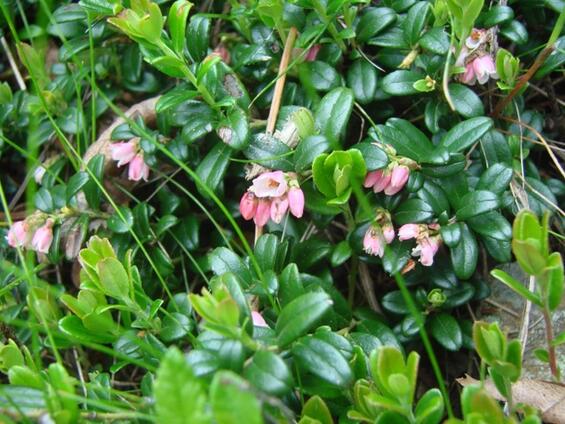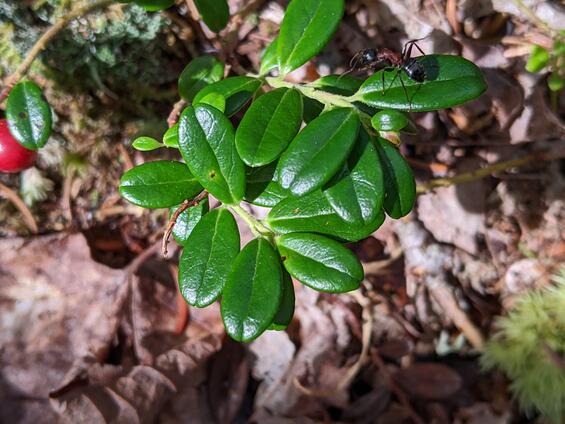- Scientific name: Vaccinium vitis-idaea L.
- Species of Greatest Conservation Need (MA State Wildlife Action Plan)
- Endangered (MA Endangered Species Act)
Description

Mountain cranberry is an evergreen dwarf shrub with erect, slender, branching stems, 15 cm (6 in) high. The branchlets are greenish-brown to reddish, nearly smooth, or with short curly white hairs. The leaves are alternate, oval-shaped with a rounded tip, a dark green color, and measure 2 cm (0.8 in) long. They are pale and black-dotted underneath. The flower is bell-shaped, 4-5 lobed, and a white or pinkish color. The fruit is an edible dark red berry, 8-10 mm (0.3-0.4 in) long. The flowering season is June–July.
Life cycle and behavior
This is an evergreen species.

Population status
Mountain cranberry is currently listed as an endangered species in the state of Massachusetts. MassWildlife’s Natural Heritage & Endangered Species Program database has 4 records from 3 counties: Berkshire, Essex, and Worcester. Only 1 of those records is within the last 25-year period.
Distribution and abundance
Mountain cranberry is distributed from Greenland to British Columbia, south to the Great Lakes region, and the high mountains of northern New England.

Habitat
This species favors dry, peaty acid soil, in rocky or sandy clearings at high elevations.
Healthy habitats are vital for supporting native wildlife and plants. Explore habitats and learn about conservation and restoration in Massachusetts.
Threats

The primary cause of rarity in Massachusetts is the very limited amount of habitat in the state. As with many alpine or subalpine plants, Mountain cranberry is quite susceptible to trampling on mountain summits, but at present, this is not a problem in Massachusetts. However the one remaining population is close to a road and road bank. Erosion around this road bank mgiht become a situation that threatens this population.
Conservation
At present the one active population has been relatively stable but is under-surveyed. It needs to be more precisely measured and assessed to establish clear baseline data from which to compare changes over time. If it is determined that a physical threat occurs to this population, such as roadside erosion, steps need to be taken to ensure long-term viability.
Research is needed to determine if a new population could be established from seeds of the one remaining population.
Contact
| Date published: | May 7, 2025 |
|---|